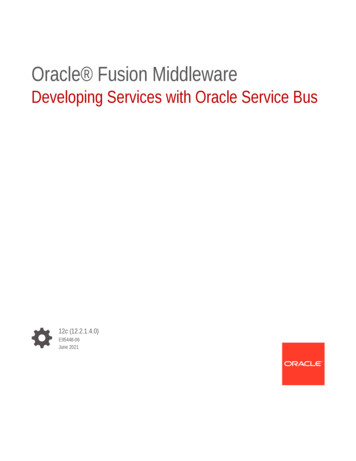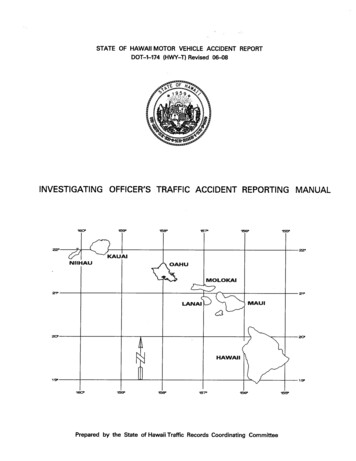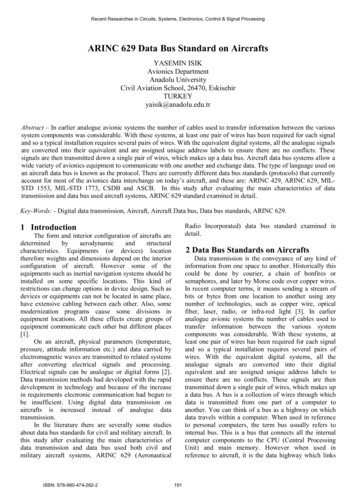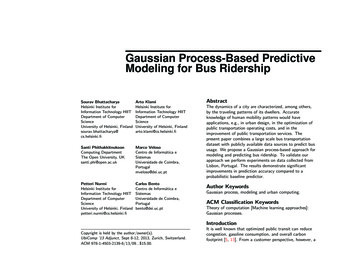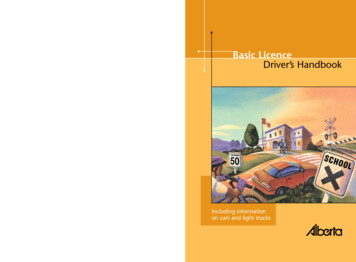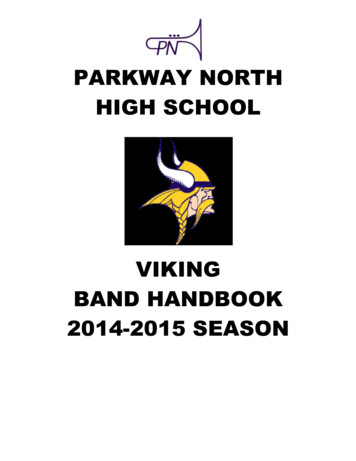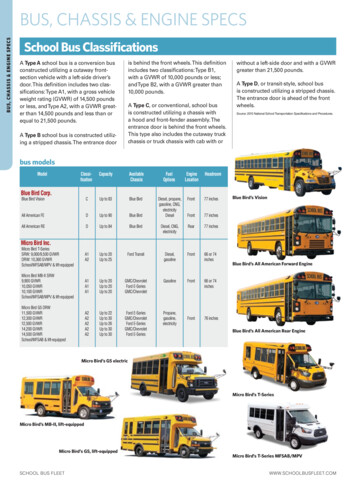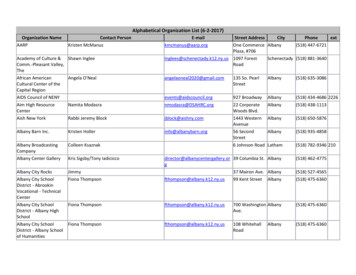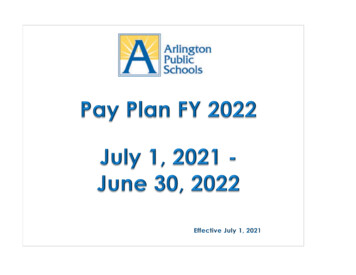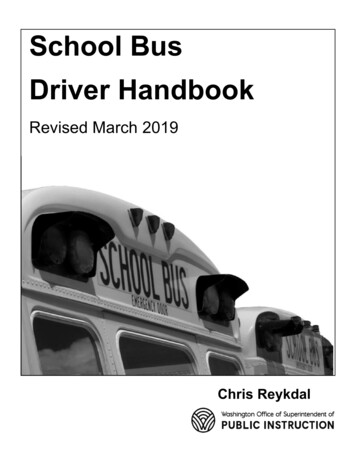
Transcription
School BusDriver HandbookRevised March 2019Chris Reykdal
Office of Superintendent of Public InstructionOld Capitol BuildingP.O. Box 47200Olympia, WA 98504-7200To obtain additional copies of this document, please visit our Web site .aspx.It is available in PDF format. Please refer to the document number provided below.19-0011OSPI provides equal access to all programs and services without discrimination basedon sex, race, creed, religion, color, national origin, age, honorably discharged veteran ormilitary status, sexual orientation including gender expression or identity, the presenceof any sensory, mental, or physical disability, or the use of a trained dog guide orservice animal by a person with a disability. Questions and complaints of allegeddiscrimination should be directed to the Equity and Civil Rights Director at (360) 7256162 or P.O. Box 47200 Olympia, WA 98504-7200.
SCHOOL BUS DRIVER HANDBOOKCHRIS REYKDALState Superintendent of Public InstructionT. J. KELLYChief Financial OfficerK–12 Financial ResourcesPATTI ENBODYDirectorStudent TransportationAugust 2017Note: The Office of Superintendent of Public Instruction (OSPI) is committed to providingaccess to all individuals seeking information on our website. Some changes to the layout anddesign of this document have been made in order to make it compliant with the Americans withDisabilities Act and the OSPI Accessibility Policy.
AcknowledgmentsThis revision of the School Bus Driver Handbook was based on previous versions.Therefore, it is only right that all those involved in the development of driver handbooksover the years be acknowledged. Unfortunately, no comprehensive list of thoseindividuals exists. Isaac Newton said: “If I have seen further, it is by standing on theshoulders of giants.” Likewise, those who worked on this handbook have been able tostand on the shoulders of those giants in the field of student transportation inWashington State. We thank you.Special mention is reserved for the state driver training committee and those dedicatedprofessionals, the regional transportation coordinators of the Educational ServiceDistricts (ESDs):Rodney McKnight, ESD 112 & ESD 113Michael Shahan, Puget Sound ESD 121 & Olympic ESD 114Mark Dennis, Northwest ESD 189Dan Payne, ESD 105, ESD 123 & ESD 171Chris Jose, Northeast Washington ESD 101
Table of ContentsSCHOOL BUS DRIVER HANDBOOK . iIntroduction . 2SCHOOL BUS DRIVER REQUIREMENTS . 1School Bus Driver Authorization . 1Initial Requirements . 1Continuing Requirements . 2Disqualifying Conditions . 2Diabetes Waiver Program . 3Professional Misconduct . 4Reporting Requirements. 4Commercial Driver License (CDL) Requirements . 5Drug and Alcohol Testing Requirements . 5Pre-Employment Testing for Controlled Substances . 6Random Drug and Alcohol Testing . 6Post-accident Drug and Alcohol Testing . 6Reasonable suspicion drug and alcohol testing . 7Refusal to Submit to a Drug or Alcohol Test . 7School District Employee Requirements . 8Policies and Procedures . 8Reporting Suspected Child Abuse and/or Neglect . 8Child Abuse or Neglect Disclosure . 9Reporting Harassment. 10Student Information and Confidentiality . 10In Case of Civil Emergency or Natural Disasters . 10Expectations and Responsibilities .11Driver Appearance . 11Public Relations . 11Attitude and Image Building. 12Driver Liability . 12SCHOOL BUS DRIVING REQUIREMENTS . 15School Bus Construction and Standards .15Driving Requirements.16Pre-Trip Requirements . 16
Post-Trip Requirements . 16Driver Seat Belt Use . 17Student Seating . 17Cell Phones and Music Players . 18Prohibited Items . 18Loose Items . 19Use of Strobe Lights . 19Two-way Radio Procedures . 20Fuel Conservation .21Diesel Emission and Anti-Idling Policies . 21Driving for Fuel Conservation . 22Rules for Substitutes .24Special Trip Requirements .25Field Trip and Extra-curricular Trip Requirements . 25Loading and Unloading .25Authorized Stops and Passengers . 25Driver Responsibility . 26Loading and Unloading Procedures: Approaching the Bus Stop . 26Loading and Unloading Procedures: Stopping and Securing the Bus . 27Loading and Unloading Procedures: Crossing Students / Loading - Unloading Students . 27Loading and Unloading Procedures: Departing the Bus Stop. 27Loading and Unloading Procedures: Stopping Off the Roadway . 28Loading and Unloading Procedures: Backing at Stops . 28Loading and Unloading Procedures: Danger Zones . 29Emergency Vehicles .30Violations of the 8 Light Warning System .30Establishing and Evaluating Safe Bus Stops .32Visibility . 32Stopping on Traveled Portion of Roadway . 32Blocking Intersections . 32Other Bus Stop Situations . 33Defensive Driving .34Attitude. 34Safety and Courtesy . 35Mirror Adjustment . 35Fatigue . 36
Rail Grade Crossing Procedures . 37Emergencies .39Emergency Exit Procedures . 39Collision Procedures . 40Emergency Situations . 42STUDENT MANAGEMENT . 45Rules for Passengers .45Student Management Skills .45Common Inappropriate Student Behaviors . 45Student Cell Phone Use . 49Harassment.49Sexual Harassment and Peer-to-Peer (Student-to-Student) Harassment . 50Your Duty to Notify . 51Special Education Requirements . 52Section 504 of the Rehabilitation Act .52Individuals with Disabilities Education Act – IDEA .52Transporting Special Education Students . 53Special Ed Route Emergency Procedures . 54Wheelchairs – Mobility Devices . 54Child Safety Restraint Systems . 55Parental Involvement in Transportation Requirements . 55RESOURCES . 56Training Programs.56Pupil Transportation Management Training Program (PTMTP) . 56Driver Instructor Training Course (DITC) . 56State Organizations – Conferences – Competitions .56Washington Association for Pupil Transportation (WAPT) . 56Local WAPT Chapters and Associations . 57National Organizations – Conferences - Competitions .57OSPI Publications .57Rules and Regulations .58RCW 46.61 Rules of the Road . 58WAC 392-144 School Bus Driver Qualifications . 58WAC 392-145 Transportation - Operation Rules . 58
Notes on UsageThe Office of Superintendent of Public Instruction (OSPI) has provided this handbookfor distribution to every authorized school bus driver in the state. It is intended to be aresource for school bus drivers that are in their initial training and for school bus driversthat have years of experience. It can be used to provide supplementary information tothe complete school bus driver training program, but is not intended to fully cover theschool bus driver training requirements required by Washington Administrative Code(WAC) 392-144 School Bus Driver Qualifications.There are many sections of this handbook that emphasize material that is covered inWAC 392-145 Transportation – Operations Rules. There are many requirements in theWAC that deal with the responsibilities of school bus drivers. An example is alwayshaving the headlights on while operating a school bus (WAC 392-145-050(8)). Thisrequirement is not included in the main text of this handbook, since no furtherdiscussion seems necessary. However, school bus drivers must be aware of andcomply with the requirements of the WAC, regardless whether or not a particularrequirement is included for additional discussion within this handbook.Because this handbook is intended to be used in conjunction with the CommercialDriver Guide published by the Department of Licensing (DOL), a significant amount ofmaterial that the guide covers regarding defensive driving and the operation of acommercial vehicle is not repeated here. Every school bus driver should also have acurrent copy (paper or electronic) of the Commercial Driver Guide and routinely refreshtheir knowledge of its contents.
IntroductionEvery day in the United States, over 400,000 school buses transport approximately 25million students between home and school. Collectively, school buses travel 4.3 billionmiles each year. In Washington State, school buses provide over 700,000 student tripsper day and travel over 100 million miles per year. When you consider field trips oractivity trips, nearly every student rides a school bus at some point during the schoolyear. Student transportation has the best safety record for any mode of ground-based,passenger transportation. The intent of this manual is to provide the school bus driversof Washington State with the information necessary to continue to provide every studentwith a safe ride to and from school every day.This manual provides some of the baseline information you learned when you were firsttrained to become a school bus driver. When encountering situations that raisequestions, drivers should look to their local district school bus driver instructors and/orsupervisor for additional assistance.In Washington State, the majority of school bus drivers are employed directly by schooldistricts, however, a significant number are employed by private companies contractingtransportation services to school districts. Regardless of the employer, all school busdrivers operating school buses transporting public school students in the state ofWashington are held to the same stringent qualifications, with the goal of ensuring thatonly the “best of the best” are allowed to transport our students. We hope this handbookwill enhance your skills; our State’s dedicated, school bus drivers. Thanks for the greatjob you do!
SCHOOL BUS DRIVER REQUIREMENTSSchool Bus Driver AuthorizationBefore you can drive students for a public school in Washington State, the schooldistrict you are going to be working for must have you authorized as a school bus driverby OSPI. The authorization is separate from any requirement related to your driverlicense issued by DOL, including the school bus endorsement. You are not issued anycard or certificate indicating that you are an authorized school bus driver. The schooldistrict will make the application once you meet all the requirements. The district isnotified when the authorization is approved.You must be authorized by each school district you work for as a school bus driver. Youmay be working as a substitute driver for a couple of local districts, for instance. In thatcase, each district must have you authorized separately. Some districts are set up ascooperatives and they may choose to handle authorizations in a number of differentways. While the school district will complete the application process for your school busdriver authorization, it is your responsibility to ensure you meet the authorizationrequirements.The authorization requirements for school bus drivers are found in WAC 392-144. A linkto all the current rules and regulations can be found in the resource section at the end ofthis handbook and is also available on the OSPI Student Transportation webpage athttp://www.k12.wa.us/transportation/Initial RequirementsThe initial authorization requirements for a school bus driver are found in WAC 392-144101, and are summarized here: Have at least five years of experience driving a passenger car.Complete a Washington State Patrol and a Federal Bureau of Investigationbackground record check that does not indicate any disqualifying conditions.Complete a school bus driver training program overseen by an authorized schoolbus driver instructor.Meet all the continuing requirements for holding a school bus driverauthorization, including a review of a five-year school bus driver abstract of yourdriver record.Note that you are required to meet all the continuing requirements.1
Continuing RequirementsThe continuing requirements for maintaining a school bus driver authorization are foundin WAC 392-144-102 and are summarized and described here: Have a valid, appropriate driver license for the type of vehicle you are operating.In some school districts, standard motor pool vehicles are used to transport somestudents to and from school. In this case, the driver of the vehicle may not need acommercial driver license, since it is not required for the vehicle. The driver stillhas to be an authorized school bus driver.Complete the annual school bus drivers in-service training, no later thanNovember 1st of each school year. This training is provided by the school districtor contractor.Have current first aid training. Typically, the school district or contractor providesthis training. The district determines what first aid training is acceptable. Note thatwhile CPR is included as an integral part of many first aid training programs,CPR is not required training. Remember that there is specific CPR trainingnecessary for children. Use of adult CPR on small children may result in injury tothe child.Complete and submit to the school district, an annual disclosure form of crimesagainst children and other disciplinary actions.Be able to demonstrate the physical ability to perform the job functions of aschool bus driver.Have a current, valid medical examiner’s certificate. Medical examiner’scertificates are valid for not more than two years, but can be required more oftenby the medical examiner. Always carry the medical examiner’s certificate withyou when driving a commercial vehicle. As of May 21, 2014, the physicalexamination must be conducted by a medical examiner listed on the NationalRegistry of Certified Medical Examiners.Disqualifying ConditionsA complete list of the disqualifying conditions for a school bus driver is found in WAC392-144-103. However, the most common disqualifications are: Having your personal driving privileges revoked or suspended as a result of amoving violation or having your commercial driver license disqualified,suspended, or revoked within the preceding five years.Having three or more speeding tickets or other serious motor vehicle violations,including any alcohol related offense within the preceding five years.Having refused a drug or alcohol test or had a positive drug or alcohol test.2
There are many other disqualifying conditions listed in WAC 392-144-103, primarilydealing with the convictions for various crimes. If you have concern about the otherdisqualifying conditions, please see full text of the current WAC 392-144.Diabetes Waiver ProgramDiabetes is an increasingly common, serious medical condition. While a full discussionof all aspects of diabetes is beyond the scope of this handbook, proper diet andadequate exercise can reduce the risk of developing diabetes.Individuals with diabetes who are treated with insulin are allowed to be authorizedschool bus drivers, depending on the stability provided by their treatment. There are anumber of additional requirements provided in detail in WAC 392-144-020(9)(d). This isa waiver process implemented by OSPI and managed by the school district. It is aseparate process from any medical waiver required by DOL. There is also a separatewaiver process available from the federal government. The main difference (besides thelonger waiting period for the federal waiver) is that with the DOL/OSPI process, you areonly allowed to operate a school bus within Washington State. For instance, you wouldneed a federal waiver to be able to drive a field trip to Portland.For an individual with diabetes, following your doctor’s recommendations is extremelyimportant. You should discuss with your doctor the requirements for a school bus driverwith diabetes being treated with insulin. Make sure that your doctor is aware that whenyou initially beginning treatment with insulin, you will not be allowed to drive a schoolbus for a period of at least 90 calendar days. Working with your doctor, it may bepossible to have this coincide with the summer break.3
Professional MisconductFor a school bus driver, professional misconduct refers to acts that are in violation ofthe rules and regulations for operating a school bus that put your passengers or coworkers at risk. Professional misconduct can result in the revocation of your school busdriver authorization.One example of professional misconduct is failure to ensure that there are no studentsleft on the bus at the end of your route. Checking your bus for students at the end ofeach route is required by WAC 392-145-041 and failure to do so can result in seriousrisk to the well-being of a student under your supervision.Only an administrator of the employing school district can report a charge ofprofessional misconduct to OSPI. Typically, OSPI will require a pattern of behavior withmore than a single incident of professional misconduct before the school bus driverauthorization is revoked. However, a single occurrence may result in revocation if theact results in personal injury or a single occurrence may result in a suspension of theauthorization for an act resulting in significant risk of personal injury.Reference: WAC 392-144-020(8) Professional MisconductReporting RequirementsEvery authorized school bus driver is required by WAC 392-144-140, to notify his or heremployer in writing within 20 calendar days of:1. The filing of any criminal charge for conduct that is a disqualifying condition in WAC392-144-103.2. Any disqualifying traffic convictions or license suspension or revocation ordersissued by the Department of Licensing.The written notification must include the driver’s name, driver license number, the courtwhere the action is taking place and the case number assigned. Failure to notify canresult in revocation of the school bus driver’s authorization regardless of the result ofthe court process. This is important and worth repeating: if you fail to notify youremployer, it can result in you losing your job, even if you are found not guilty or if thetraffic violation is later amended to a non-disqualifying infraction.4
Commercial Driver License (CDL) RequirementsWashington State law requires that anyone driving a school bus must have acommercial driver license (CDL) Class B or C (depending on the size of school bus), apassenger endorsement, a school bus endorsement and the air brake restrictionremoved (if you are driving a bus with air brakes).Obtaining a CDL requires written tests (administered by DOL) on such topics asgeneral knowledge, passenger management, knowledge of air brakes and school busoperations. The skills test (demonstrating your ability to safely operate a school bus)includes pre-trip and post-trip inspections and behind-the-wheel driving tests in aschool bus.There are separate legal requirements for drivers of commercial vehicles that are notincluded in WAC 392-144: You are required to notify your employer if your license is suspended, revoked, orcancelled or if you are disqualified from operating a commercial vehicle. You arerequired to notify your employer before the end of the business day following theday you received notice of the action.Note that under WAC 392-144-103, you will lose your authorization if you drive aschool bus with a suspended, revoked, cancelled or disqualified commercialdriver license, and there is no provision to allow you to drive until the end of theday following your notification.You must notify your employer, in writing, of all traffic convictions within 30 days.This includes those in a private automobile as well as while driving a commercialvehicle.There are other requirements for commercial drivers. See the introductory chapters ofthe Commercial Driver Guide published by DOL.Drug and Alcohol Testing RequirementsCode of Federal Regulations (CFR) 49, Part 382 contains the requirements for the drugand alcohol testing of commercial drivers. The purpose of the drug and alcohol testingprogram is to help prevent accidents and injuries resulting from the misuse of alcohol orthe use of controlled substances by drivers of commercial motor vehicles. This partapplies to all drivers and to all employers of drivers who operate commercial motorvehicles subject to the CDL requirements. In Washington, this includes school busdrivers and all other safety sensitive positions (such
It is available in PDF format. Please refer to the document number provided below. 19-0011 OSPI provides equal access to all programs and services without discrimination based on sex, race, creed, religion, color, national origin, age, honorably discharged veteran or
